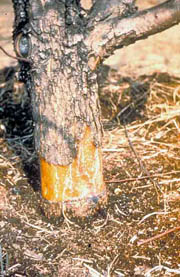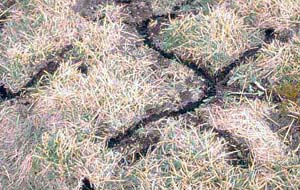Voles | |
|---|---|
| November 20, 2007 | |
|
People often refer to voles as meadow mice or “field mice.” In North America, there are 19 species; but the meadow vole, Microtus pennsylvanicus; the prairie vole, Microtus ochrogaster; and the pine vole, Microtus pinetorum, are of the greatest pest significance in turf and landscaped areas. Voles damage turf and gnaw on the trunks and roots of various ornamental plants. In general, voles are compact rodents with stocky bodies, short legs, and short tails. Their eyes are small, and their ears are partially hidden. They usually are brown or gray, although many color variations exist. The adult vole ranges from 3-1/2 to 5 inches long. Mainly, they eat the stems and leaves of various grasses, but they also consume other vegetation. Voles do not hibernate and are active throughout the year, mostly at dawn and dusk. Most voles do not live for more than a few months. If they are not killed by a predator, a vole can live for up to 2 years.  The meadow vole constructs well-defined, visible surface runways through turf areas measuring about 1-1/2 to 2 inches wide. Vole runways in turf are formed by a combination of the vole’s eating the grass blades and its constant traveling over the runway. These creatures also spread excavated dirt from the burrow system in the runway, causing a dirt-bare path in some areas.  The nests of voles may be constructed on the surface, in underground burrows, or beneath the protection of an object lying on the ground. Burrows may be located beneath protective cover such as vegetation or shrubbery, beneath a rock, or beneath raised gardens and planter boxes. Residences with low-lying landscaping, such as arborvitae, creeping yews, junipers, and similar species, are good candidates for vole activity. Burrow entrances measure from 1 to 1-1/2 inches in diameter. Voles burrow into the root system of ornamental plants, resulting in leaning young trees and dieback on shrubs and young trees. The opening of the burrow is usually near the base of the plant and is easily seen. Bark-feeding at the base of trees and shrubs during the winter may also cause dieback the following summer. Close examination of affected plants shows extensive bark removal. Realize that damage is likely to be more severe during extended cold spells with deep snow cover. In some cases, management may be needed only in the form of fencing or repellents during those times. As mentioned earlier, voles are most prolific when they have abundant amounts of vegetation and cover. If you eliminate weeds and dense ground cover around lawns, these areas are less able to support voles. Mow lawns and other turf regularly, and clear mulch 3 feet or more from the bases of trees as winter approaches in areas of vole activity. Keep the snow cleared away from the base of young trees. Voles have many predators, including cats, dogs, weasels, skunks, raccoons, coyotes, foxes, hawks, and owls. Reducing cover in the form of mulch, groundcover plantings, snow, and frequent mowing makes them much more vulnerable to these predators. Typically, removal of cover is sufficient to eliminate vole problems. Voles are susceptible to other methods of control typically used to control house mice. Snap traps are effective baited with a combination of peanut butter and oatmeal or with apple slices. House mouse poison baits are also effective. Unfortunately, birds and other wildlife can also be killed by these methods unless they are placed in bait boxes that only voles and similar small animals can enter. Repellents utilizing thiram (also a fungicide) or capsaicin (the “hot” in chilis) as an active ingredient are registered for meadow voles to protect the bases and trunks of trees. These products (or repellents using other ingredients and registered for other garden and turf pests such as rabbits, chipmunks, etc.) may afford very short-term protection, but the use of repellents is generally not recommended due to low efficacy. Finally, no types of frightening agents are effective against voles; and no plant exists which, when planted, will repel or scare voles away from an area. |
